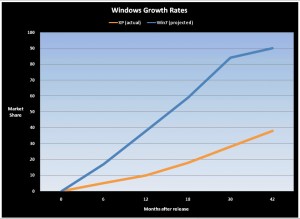The echo chamber misreads another Windows 7 survey

Earlier today, ScriptLogic, a software developer that specializes in Windows management software, published the results of a Windows 7 adoption survey they conducted recently. A summary of the survey data, from 1100 IT pros, is available for download from ScriptLogic here (PDF). The summary includes no analysis. Apparently, ScriptLogic assumed that anyone reading this handout would be able to interpret the survey results correctly.
Ha ha ha.
ScriptLogic did provide a brief introduction and analysis on the download page for the report. Here is the entire two-paragraph introduction, which a literate adult can read in probably 30 seconds. It might take a minute or two if you move your lips while reading. Go ahead, I’ll wait:
The primary goal of this survey was to assess the impact of the weak economy on IT infrastructure projects and we found that, despite its impact on short-term plans, 41% of organizations [emphasis in original] plan a wholesale migration to Windows 7 by the end of 2010. This is actually a strong adoption rate when compared to the historical adoption rate of Windows XP in its first year which was cited as 12-14%. [emphasis added]
Furthermore, in ScriptLogic’s primary market segment it is usual for businesses to upgrade operating systems piecemeal as they purchase new desktop hardware, so the fact that nearly half of organizations surveyed are planning major rollouts during 2009-2010 indicates a high acceptance of Windows 7 among small and medium businesses. [emphasis added]
Seems pretty clear, right? "Wholesale migration" by more than 40% of businesses in just over a year. My first reaction when I read that was "Holy crap, that's a big number!"
In fact, this new survey confirms the results of two other surveys taken earlier this year by different organizations, which I wrote about on April 16 (see Will Windows 7 be Microsoft's biggest business hit ever?). That 41% adoption rate, roughly 14 months after Windows 7 goes on sale, plots almost perfectly onto the graph I created for that post and have reprinted here. The blue line is projected Windows 7 adoption rates over the next three years, the orange line is actual Windows XP adoption over an equivalent amount of time:
Given this data, one would think the technical press would be reporting the obvious conclusion to be drawn from this survey: Even in the midst of the worst worldwide recession in recent memory, Windows 7 is shaping up to be one of Microsoft’s biggest success stories ever. Right?
Again: ha ha ha.
Here is a depressingly representative sampling of the actual headlines I read on Google News today:
- Reuters, Six in 10 companies plan to skip Windows 7: survey
- PC World: Does Anybody Want Windows 7? Most IT Pros Say "No"
- Electronista: 60% of businesses to avoid Windows 7
- Computerworld: Survey: 6 in 10 companies to skip Windows 7
- Daily Finance: As Microsoft prepares to release Windows 7, tech world prepares to yawn
- All Things Digital: Six in Ten Businesses Suffering From Post-Traumatic Vista Syndrome
- Information Week Weblog: Windows 7 A No-Go For Business, Survey Says
- CNET News: Survey: Many businesses plan to skip Windows 7
Huh?
Out of all those reports, only John Paczkowski of All Things Digital grudgingly noted that this is “a high level of adoption for a new OS, especially in the current economic climate.” In the final graf, after saying Windows 7 will be “ignored” because of “hesitation” by “gun-shy” IT pros.
Yes, it’s a high level of adoption, but not high enough, I guess. For today’s jaded technical press and pundits, anything less than 100% adoption, overnight, is a colossal failure. Which is kind of like saying that this year’s Star Trek was a flop because 268 million Americans didn’t go see it.
Meanwhile, in yesterday’s news (literally), PC World summarized a new report by IDC analyst Al Gillen, which predicts that Windows 7 will account for 75% of units shipped in 2011 and will achieve total world domination within three years:
Windows 7 momentum will translate in 2013 to the new OS accounting for 95% of the operating systems Microsoft sells to businesses. That percentage is up from 90% forecast for 2012.
What, not 100%? Losers.
